The versatile nature of glass means that it can be found in a wide variety of antiques and contemporary design. With the oldest known use of glass dating back to the stone age, the vast history of the material has resulted in numerous uses across hundreds of years. Whilst the fragility of glass may result in much of these artefacts being lost to history, there are plenty of examples that have stood up to the test of time.

The history and value of antique glass
Intricate designs on Roman ‘cage cups’ from the 4th century are a rare but notable example of this survival. The Constable-Maxwell cage cup sold for £2,646,650 in 2004 as the most expensive glassware item to be sold at auction.
 Above: a selection of ancient glass including (from left to right) a brown glass jug, a gold band mosaic bottle, a 1st century jug, a snake-thread dropper flask and a hexagonal amphoriskos
Above: a selection of ancient glass including (from left to right) a brown glass jug, a gold band mosaic bottle, a 1st century jug, a snake-thread dropper flask and a hexagonal amphoriskos
Glassware from ancient Greece also still exists today, most notably the ‘Berlin glass amphora’ from the Hellenistic period. The amphora is the largest glass item lasting from antiquity at 59.6cm tall. Although it has survived thousands of years, the glass which was originally pale green is now milky yellow in tone due to historic exposure to sunlight.
 Above: a selection of ancient glass amphoriskos
Above: a selection of ancient glass amphoriskos
Stained glass windows in places of worship became popular in the 12th century with the rise of romanesque and gothic design, the diverse colours in such window designs were usually created by infusing metallic salts during the glass creation. This type of coloured glass generally does not deteriorate in vibrancy over time, which is why we still have such extravagant examples of it today. However, if the stained glass has been painted rather than coloured during the manufacturing process, it is likely to fade due to the UV rays affecting the chemicals of historic paint pigments.
 Above: a detail from a 14th century Stained Glass Panel depicting The Visitation
Above: a detail from a 14th century Stained Glass Panel depicting The Visitation
From the 17th century onwards, glass manufacturing became a more streamlined industrialised process with the invention of easily produced clear lead crystal glass or ‘flint glass’. This was developed by George Ravenscroft, who produced various items of glassware (such as wine glasses, bowls, plates and vases) with this method after finding ways to reduce the number of inherent issues and impurities in the glass, which might make it become cloudy or cracked over time. Today, you will find Ravenscroft’s glassware in museums around the world as an example of this industrial revolution. In 2020, a simple and unassuming glass candlestick attributed to Ravenscroft sold for £4,600.
 Above: a 19th century opal opaque vase, a perfume decanter, a pink opaque glass vase, a green glass flask, an amberina covered jar and a paperweight
Above: a 19th century opal opaque vase, a perfume decanter, a pink opaque glass vase, a green glass flask, an amberina covered jar and a paperweight
By the 19th century industrial glass was so widely available that it was chosen as the building material for the 1851 creation of the Crystal Palace, the 990,000 square foot glasshouse, which hosted the ‘Great Exhibition of the Works of Industry of All Nations’. Coloured glassware also became popular in the home, with many household and decorative pieces surviving today as popular antiques.
 Above: a selection of Lalique glass ornaments
Above: a selection of Lalique glass ornaments
Coloured glassware remained popular through to the 20th century when it was revived in pieces from the Art Deco and Art Nouveau movements. Tiffany glass was a product of this decorative preference, with the iconic stained-glass lampshades and windows originating in New York between 1878 and 1933. In 1997, a Tiffany lamp sold for $2.8 million at Christie’s. A good example of Tiffany glass is often in the region of $100,000-150,000, with those featuring dragonflies and peacock colours being at the higher end of the price range.
 Above: a selection of Tiffany favrile glass items
Above: a selection of Tiffany favrile glass items
Glass vases, bottles, and paperweights have a wide collectors market with auctions regularly held across the world. In December 2020, an antique Venetian vase sold for £42,750. In 2019, a 19th-century cameo vase was estimated at £120,000-150,000 and sold for £206,313 at Bonhams, London.
Challenges in caring for glassware
Knowing how to care for glass objects, decorations or artworks will ensure that they are protected and will reach their asking price or beyond during auction. Similarly, preserving sentimentally important glass pieces, such as family heirlooms or personal collections, is just as vital for the longevity of the fragile material and the memories associated with them.
 Above: detail of a covered goblet produced by New Bremen Glass Manufactory, 1788
Above: detail of a covered goblet produced by New Bremen Glass Manufactory, 1788
Clear glass which has survived hundreds or thousands of years will likely be stable due to the perfection of the chemical combination which was used during its production. Whilst UV rays from the sun are likely to fade a coloured glass and extreme temperatures may cause cracks or breakages, well-made glass is quite a durable material when it is kept in the right conditions. However, inherent conditions which may affect historic glass include crizzling and iridescence.
 Above: glassware from ancient Rome showing typical signs of iridescence due to their age
Above: glassware from ancient Rome showing typical signs of iridescence due to their age
Crizzling is a deterioration that is also seen as a glass ‘disease’, it can appear as very fine cracking upon the surface, this is caused by an imbalance in the chemicals of the glass manufacturing. Crizzling can also make the glass ‘sweat’ in humid conditions and can diminish the transparency. If a glass item is seen to be suffering from crizzling, it is advisable for it to be placed in a location with average humidity levels. This should prevent the continued decay from occurring.
 Above: crizzling can make clear glass appear totally opaque
Above: crizzling can make clear glass appear totally opaque
Iridescence is the fracturing of the glass surface, these layers often form with a light rainbow shine which is why they are referred to in this way. As the deterioration continues, the layers may begin to flake away from the structure. Visually, this may not be able to be resolved, but the likelihood of complete loss can be drastically reduced through specialist treatment by our conservator.
Cleaning glassware
Glassware with signs of deterioration should be handled and moved as little as possible. This includes cleaning the surface of items that have evidence of crizzling or iridescence. If a piece is stable and does not have areas of gilded decoration (paint which sits on top of the glass), it can be dusted gently with a dry, clean and soft paintbrush, ensuring that it is secure as the brushing takes place. If it needs a deeper clean, tepid water in a sink can be used, as long as the sink itself is padded with foam or other protective materials to avoid accidental knocks, which could lead to devastating damage. The glass can be dried with a light cloth, or left to air dry in a stable environment. Glass items can also be professionally cleaned by our conservation team.
 Above: some discolouration may be age related patina as seen on this 4th century glass bowl
Above: some discolouration may be age related patina as seen on this 4th century glass bowl
Like many other objects, glass can also be vulnerable to mould growth. However, this is not due to the glass itself, but the contents which it may have held historically or recently. A clouded appearance may appear on the interior surface of the glass through mould spores or chalky limescale from tap water. Although there are often amateur solutions to such issues, it is not recommended that this is tried at home, especially in a collector’s item or a piece with high monetary value. Home cleaning techniques for this type of distortion usually have a low success rate and can cause worsened damage. Contact our team for professional cleaning services, which will both work to clean the areas of concerns and eradicate any active mould spores from returning or spreading within the home.
 Above: if glass has gilt areas or painted details this should not be rubbed in any way to avoid colour loss and abrasions
Above: if glass has gilt areas or painted details this should not be rubbed in any way to avoid colour loss and abrasions
Household cleaning agents should never be used on specialist glass, this should only be reserved for every day, low-value glass items. General washing techniques, such as the use of a dishwasher, should also be avoided when it comes to antiques or valuables. Dishwashers can lead to chipped glass and irreversible cloudiness on the surface.
 Above: stained glass windows should only be cleaned by experienced professionals, amateur attempts made lead to colour loss and abrasions
Above: stained glass windows should only be cleaned by experienced professionals, amateur attempts made lead to colour loss and abrasions
If faced with cleaning salvaged glassware, a conservator should be contacted. This includes glass items that may have been affected by an escape of water, flooding, fire, smoke, dirt and debris. These will require specialist treatments with customised cleaning solutions to remove the dirt, contaminants and any harmful elements.
Handling glass items and avoiding accidental damage
The most likely occurrence of damage with glass objects is an incident of accidental damage. This fragile material when knocked, pushed or dropped is more likely to shatter into far more pieces than ceramic materials. This is due to the often extremely thin surfaces which have been produced for visual purposes. Due to this, the display of a glass item should never be in a location that can be easily brushed against or shaken.
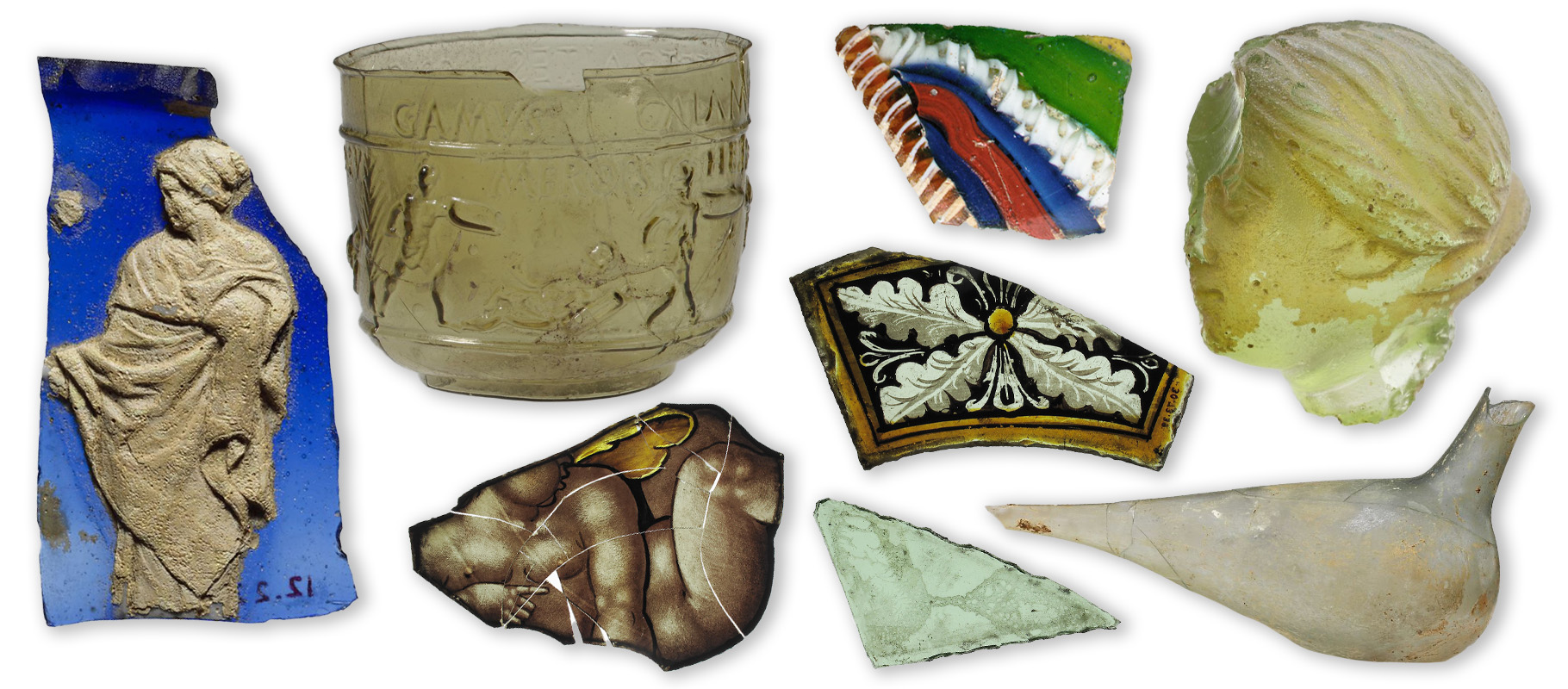
Similarly to ceramics, glass should never be picked up by delicate edges, instead it is better to hold an item with both hands and the base supported. If there is more than one piece, such as a lid, move these separately. Items should not be carried across others where possible and a clear path should be laid out when carrying or transporting them. Gloves can be worn to avoid fingerprints, but this may increase the risk of the item slipping from the grip.
 Above: a broken glass chalice from ancient Egypt, glass is most likely to break in weak areas such as the stem of a glass or neck of a vase
Above: a broken glass chalice from ancient Egypt, glass is most likely to break in weak areas such as the stem of a glass or neck of a vase
If glass requires storage or packaging for transport, a box with foam or cotton wool elements is ideal. The item itself can be wrapped in acid-free tissue paper before being securely packed into place, without too much pressure from the surrounding supports. Extra items should not be stored right alongside, but given adequate spacing and padding. Do not pile boxes on top of each other, where possible, to avoid pressure building up on lower items.
Can glass be restored?
Glass conservation is possible, ensuring the stability of glassware that is facing issues from crizzling, iridescence or cracks. Professional conservators, such as our team at Fine Art Restoration Company, are able to consolidate unstable areas with a synthetic resin, which gives strength back to the surface and helps in avoiding future deterioration. If there are historic glues or adhesives, this can be removed and replaced with non-acidic conservation approved variety. Some glass items can be taken apart and put seamlessly back together again to allow for interior cleaning and the removal of old sealants.
Below is a Jewish tear jar that was recently restored by our conservator, the breakage was repaired whilst maintaining the unique historic texture and appearance of the glass.

Our team can also advise on the best location to keep your glassware, taking into consideration the fragility of the piece, the humidity and temperature of certain areas of your home, and the use of specialist display cases. If a piece has overpainting or a surface colour that might be affected by sunlight, UV reducing glass can be discussed, which would reduce the UV rays by 70-99%.
Any extra areas of material can be assessed and restored alongside the glass, such as metallic or wooden elements. The glass may even be a minor feature in a larger piece, but our team will consider all areas for the overall longevity and protection of the item or artwork.

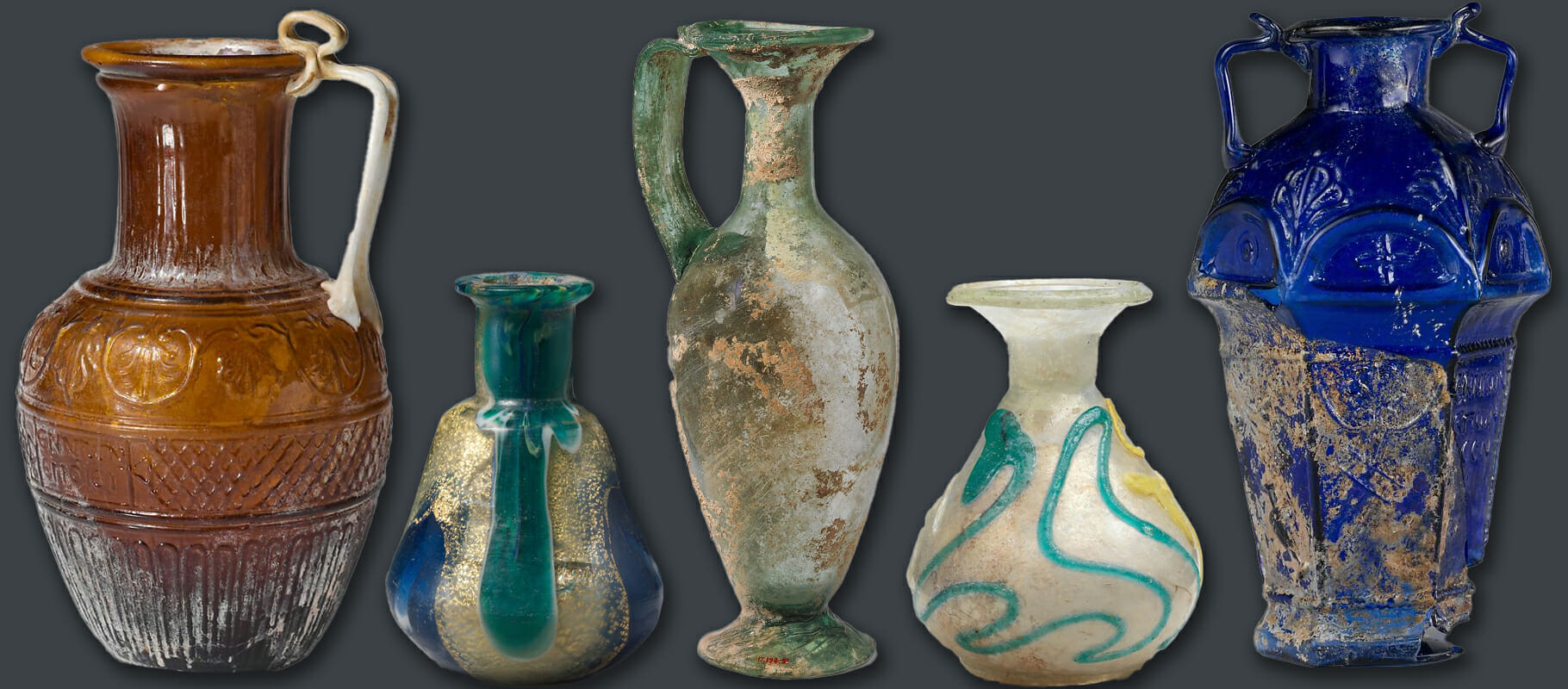 Above: a selection of ancient glass including (from left to right) a brown glass jug, a gold band mosaic bottle, a 1st century jug, a snake-thread dropper flask and a hexagonal amphoriskos
Above: a selection of ancient glass including (from left to right) a brown glass jug, a gold band mosaic bottle, a 1st century jug, a snake-thread dropper flask and a hexagonal amphoriskos Above: a selection of ancient glass amphoriskos
Above: a selection of ancient glass amphoriskos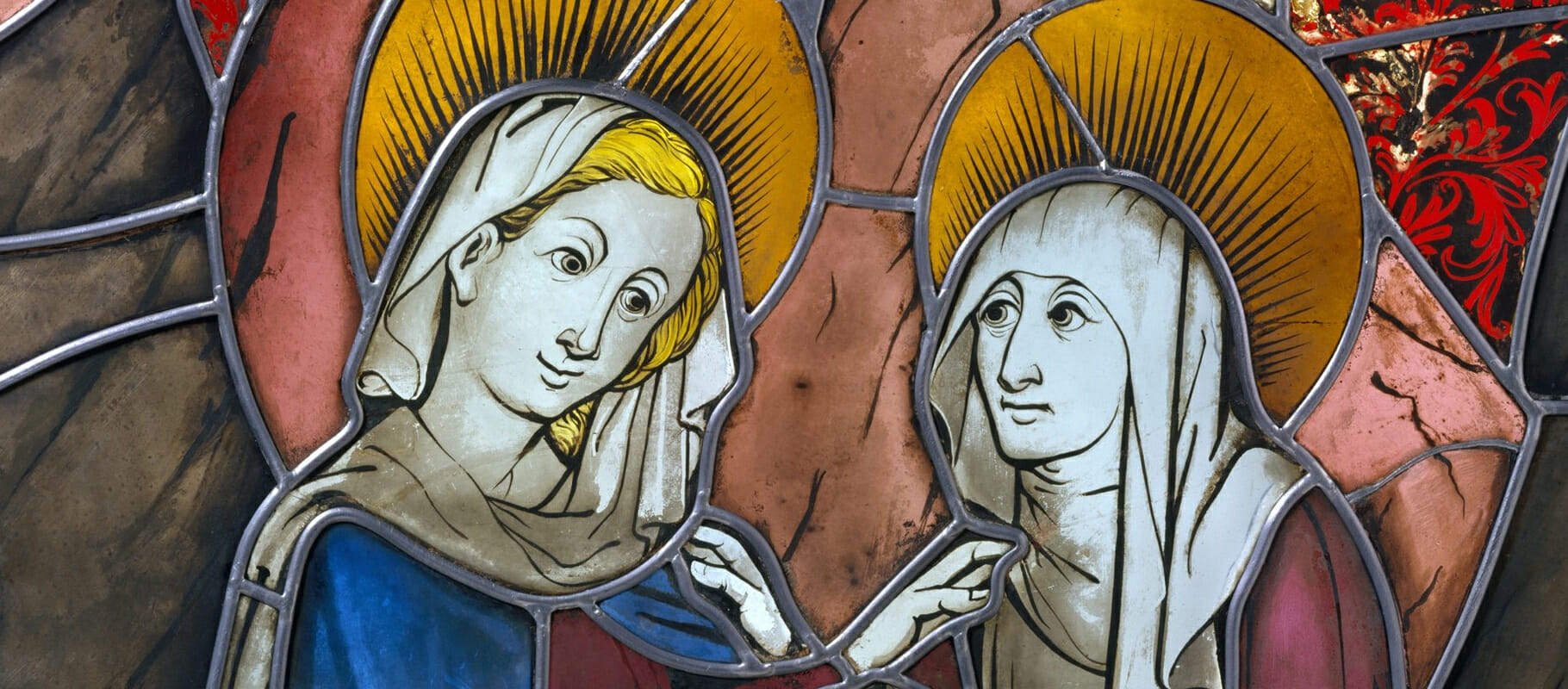 Above: a detail from a 14th century Stained Glass Panel depicting The Visitation
Above: a detail from a 14th century Stained Glass Panel depicting The Visitation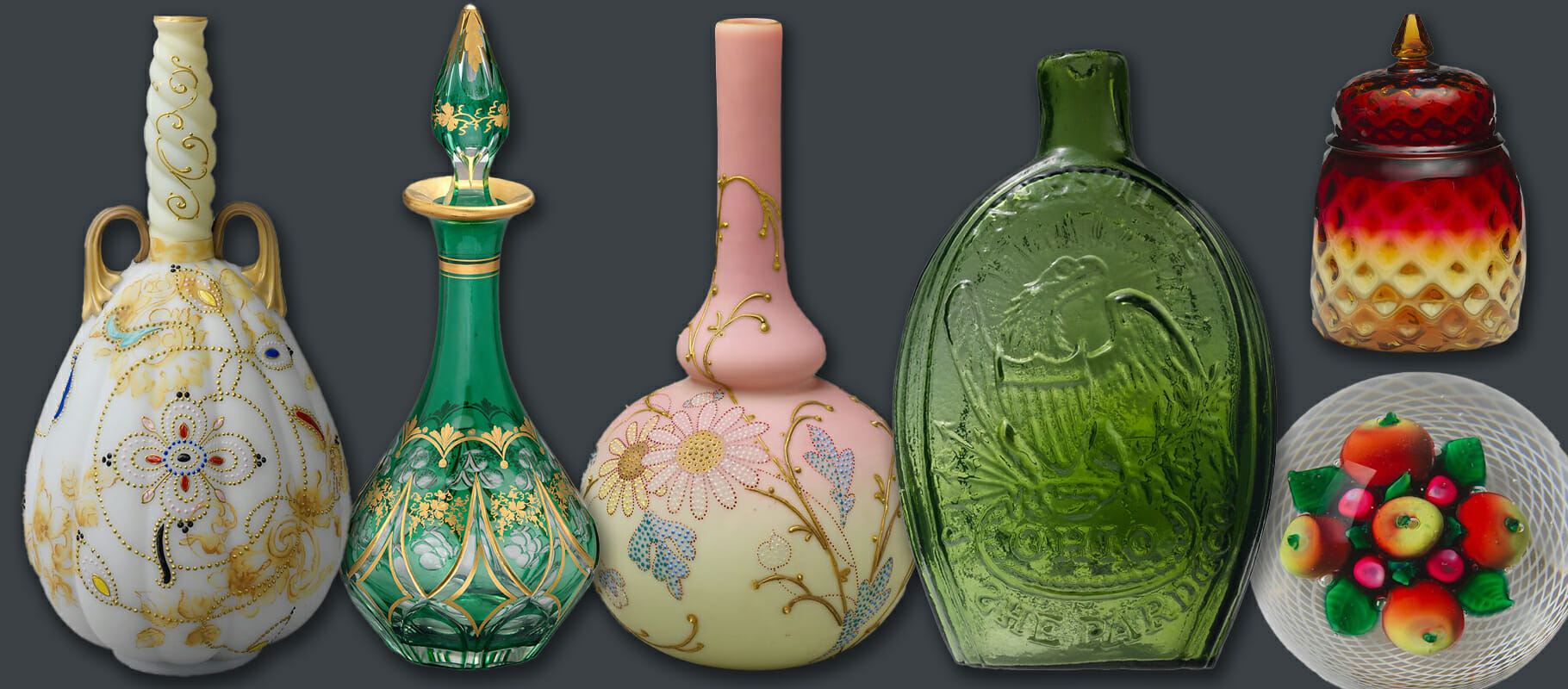 Above: a 19th century opal opaque vase, a perfume decanter, a pink opaque glass vase, a green glass flask, an amberina covered jar and a paperweight
Above: a 19th century opal opaque vase, a perfume decanter, a pink opaque glass vase, a green glass flask, an amberina covered jar and a paperweight Above: a selection of Lalique glass ornaments
Above: a selection of Lalique glass ornaments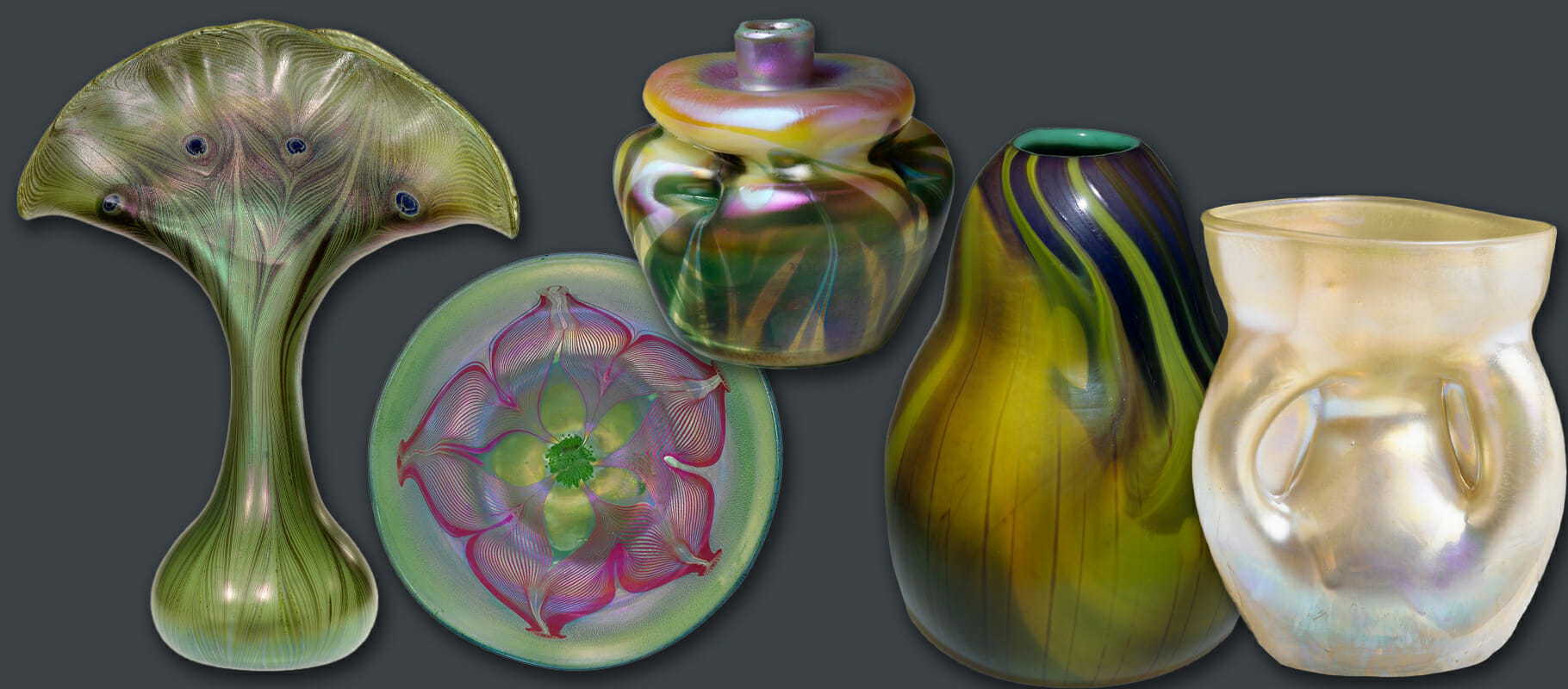 Above: a selection of Tiffany favrile glass items
Above: a selection of Tiffany favrile glass items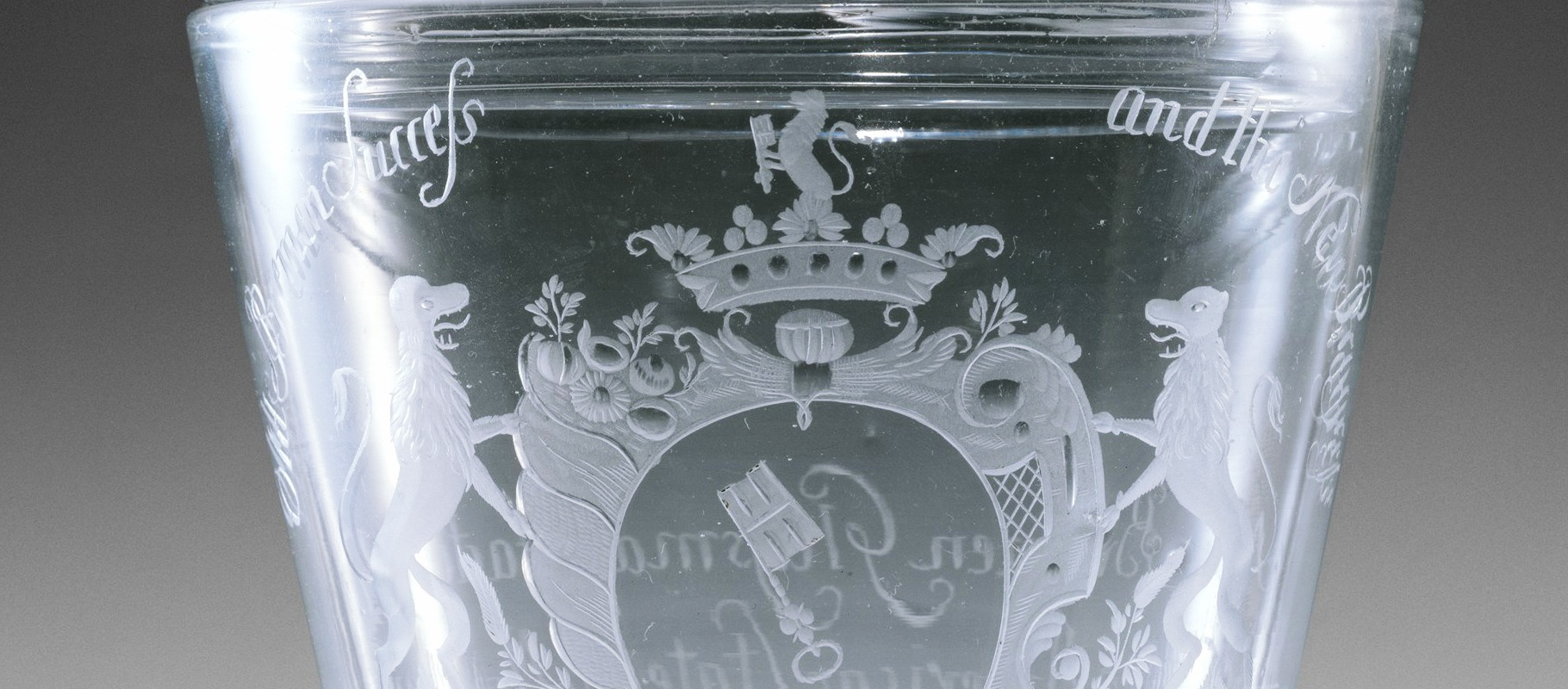 Above: detail of a covered goblet produced by New Bremen Glass Manufactory, 1788
Above: detail of a covered goblet produced by New Bremen Glass Manufactory, 1788 Above: glassware from ancient Rome showing typical signs of iridescence due to their age
Above: glassware from ancient Rome showing typical signs of iridescence due to their age 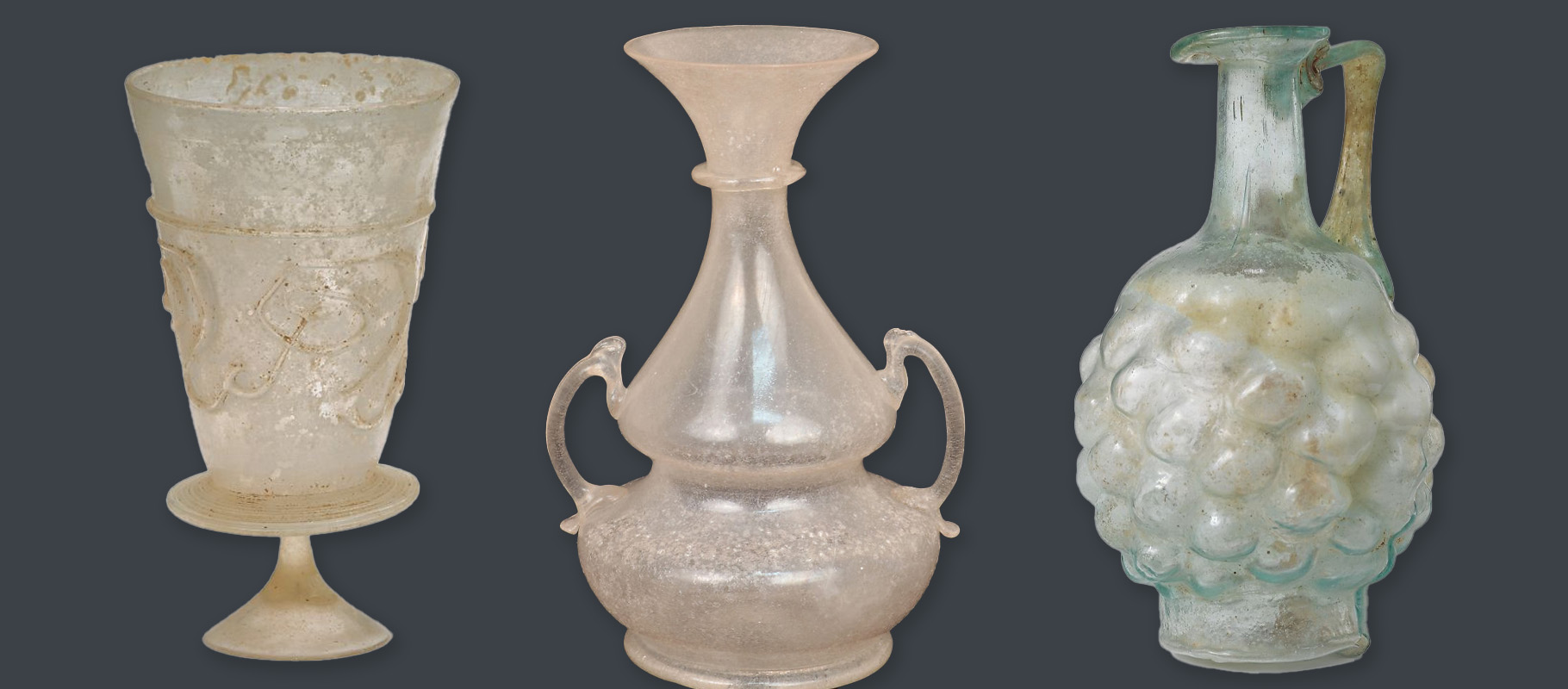 Above: crizzling can make clear glass appear totally opaque
Above: crizzling can make clear glass appear totally opaque Above: some discolouration may be age related patina as seen on this 4th century glass bowl
Above: some discolouration may be age related patina as seen on this 4th century glass bowl Above: if glass has gilt areas or painted details this should not be rubbed in any way to avoid colour loss and abrasions
Above: if glass has gilt areas or painted details this should not be rubbed in any way to avoid colour loss and abrasions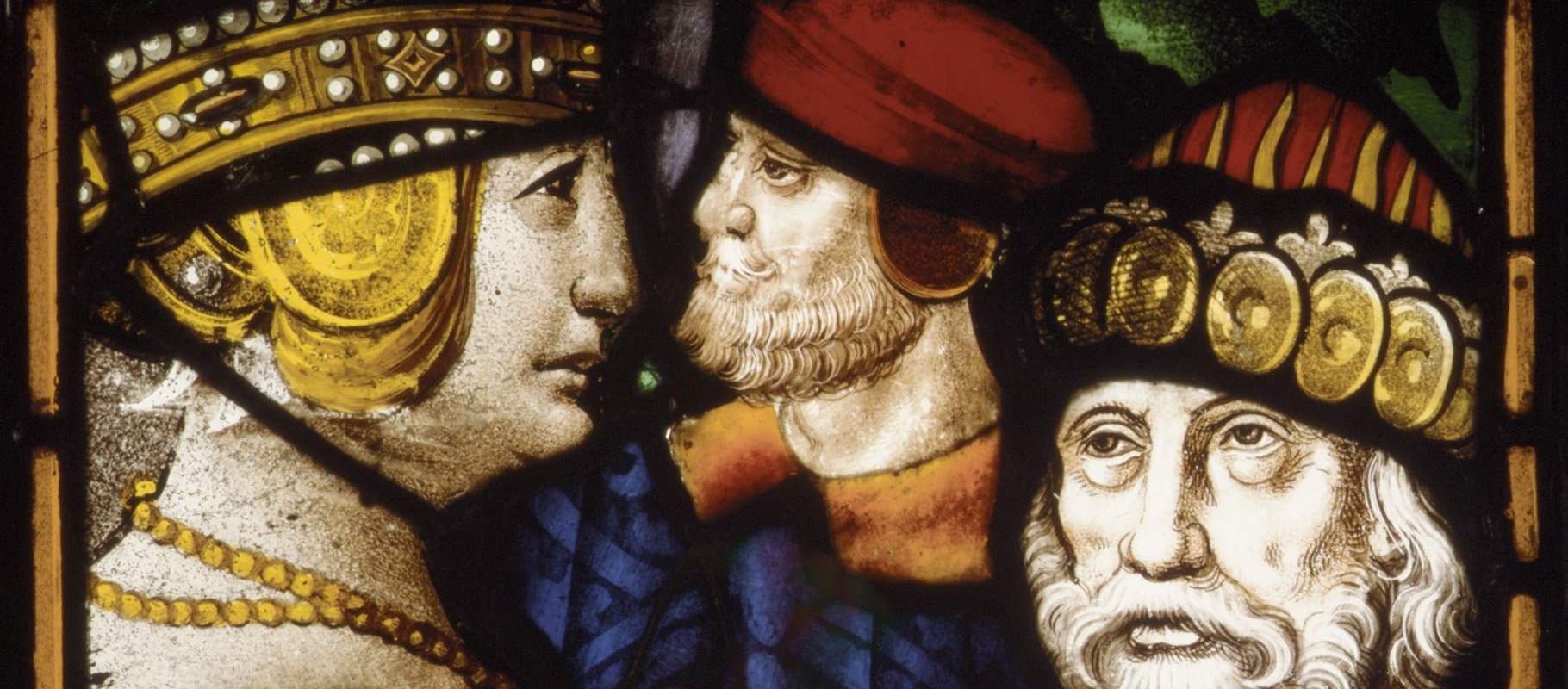 Above: stained glass windows should only be cleaned by experienced professionals, amateur attempts made lead to colour loss and abrasions
Above: stained glass windows should only be cleaned by experienced professionals, amateur attempts made lead to colour loss and abrasions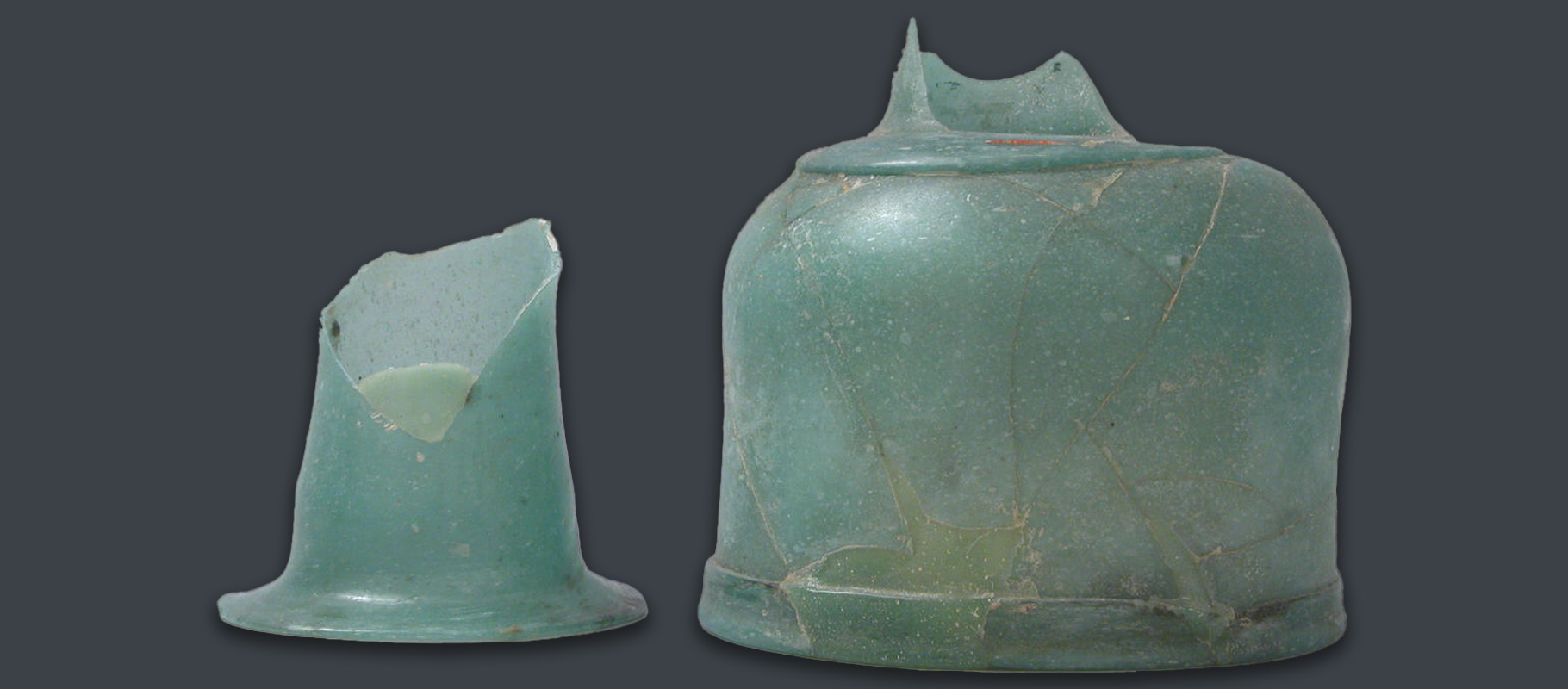 Above: a broken glass chalice from ancient Egypt, glass is most likely to break in weak areas such as the stem of a glass or neck of a vase
Above: a broken glass chalice from ancient Egypt, glass is most likely to break in weak areas such as the stem of a glass or neck of a vase




